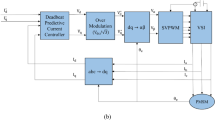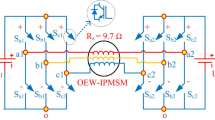Abstract
In this paper, unipolar excitation-based speed sensorless vector-controlled switched reluctance motor (SRM) drive is addressed. The use of position/speed sensors has few apprehensions in terms of price, dependability, compactness, especially from electric vehicle (EV) application view point. Therefore, for speed/torque control of SRM, it is mandatory to have some estimation technique which estimates the speed/position satisfactorily and with ease. In this paper, F-MRAS (flux-based model reference adaptive system) speed estimator is employed for estimating the speed/position. The reason for selection of this speed estimator is because of its simplicity, no large lookup table requirement and no external circuitry requirement for pulses injection. This estimator depends on stator resistance of the machine. Therefore, to make the speed estimator robust to stator resistance variations, on-line estimation of the resistance and its compensation is required. From this view point, a novel stator resistance estimator is proposed which estimates the resistance on-line. Further, this paper discusses in detail about the stability analysis of proposed resistance estimator and F-MRAS-based speed estimator. The speed estimator in combination with the proposed resistance estimator performs well in both motoring and regeneration modes. An exhaustive simulation of the drive has been carried out in MATLAB/SIMULINK. Also, the results are confirmed experimentally on a dSPACE-1104 platform.












Similar content being viewed by others
References
Haghbin S, Rabiei A, Grunditz E (2013) Switched Reluctance Motor in electric or Hybrid Vehicle Applications: A status review. IEEE Conf Indus Elect Appl (ICIEA) Melbourne, VIC, Australia 2013:117–122
Khan YA, Verma V (2019) A Novel Speed Estimation technique for a Vector Controlled Switched Reluctance Motor Drive. IET Electr Power Appl 13(8):1193–1203
Khan YA, Verma V (2018) F-MRAS based Speed Sensorless Vector Controlled Switched Reluctance Motor Drive. IEEE Inter. Conf. on Energy, Power and Environ., NIT Meghalaya, Meghalaya, India, June, 2018, 1–6.
Khan YA, Verma V (2018) A Novel Method of Estimating Stator Resistance for an F-MRAS based Speed Sensorless Vector Controlled Switched Reluctance Motor Drive. 54th International Universities Power Engineering Conference (UPEC), Bucharest, Romania, 2019.
Ehsani M, Fahimi B (2002) Elimination of Position Sensors in Switched Reluctance Motor Drives: State of the Art and Future Trends. IEEE Trans Industr Electron 49(1):40–47
Krishnan R (2017) Switched reluctance motor drives: modeling, simulation, analysis, design, and applications. CRC Press, Boca Raton London and New York Washington DC
Benbouzid MEH, Diallo D, Zeraoulia M (2007) Advanced fault-tolerant control of induction-motor drives for EV/HEV traction applications: From conventional to modern and intelligent control techniques. IEEE Trans Veh Technol 56(2):519–528
Dehghan-Azad E, Gadoue S, Atkinson D, Slater H, Barrass P, Blaabjerg F (2016) Sensorless control of IM for limp-home mode EV applications. IEEE Trans Power Electron 32(9):7140–7150
Nakao N, Akatsu K (2014). Vector control specialized for switched reluctance motor drives. In 2014 International Conference on Electrical Machines (ICEM), 943–949. IEEE.
Nakao N, Akatsu K (2014) Vector control for switched reluctance motor drives using an improved current controller. In 2014 IEEE Energy Conversion Congress and Exposition (ECCE), 1379–1386. IEEE.
Perl T, Husain I, Elbuluk M (1995) Design trends and trade-offs for sensorless operation of switched reluctance motor drives. In IAS'95. Conference Record of the 1995 IEEE Industry Applications Conference Thirtieth IAS Annual Meeting 1: 278–285. IEEE.
Harris WD, Lang JH (1990) A simple motion estimator for variable-reluctance motors. IEEE Trans Ind Appl 26(2):237–243
Acarnley PP, Hill RJ, Hooper CW (1985) Detection of rotor position in stepping and switched motors by monitoring of current waveforms. IEEE Trans Industr Electron 3:215–222
Ehsani M, Husain I, Mahajan S, Ramani KR (1994) New modulation encoding techniques for indirect rotor position sensing in switched reluctance motors. IEEE Trans Ind Appl 30(1):85–91
Cai J, Deng Z (2014) Initial rotor position estimation and sensorless control of SRM based on coordinate transformation. IEEE Trans Instrum Meas 64(4):1004–1018
Lumsdaine A, Lang JH (1990) State observers for variable-reluctance motors. IEEE Trans Industr Electron 37(2):133–142
McCann RA, Islam MS, Husain I (2001) Application of a sliding-mode observer for position and speed estimation in switched reluctance motor drives. IEEE Trans Ind Appl 37(1):51–58
Brosse A, Henneberger G (1998) Sensorless control of a switched reluctance motor using a Kalman filter. Electr Eng 81(5):297–308
Ray WF, Al-Bahadly IH (1993) Sensorless methods for determining the rotor position of switched reluctance motors. In 1993 Fifth European Conference on Power Electronics and Applications 7–13. IET.
Mvungi NH, Lahoud MA, Stephenson JM (1990) A new sensorless position detector for SR drives. In 1990 Fourth International Conference on Power Electronics and Variable-Speed Drives (Conf. Publ. No. 324) 249–252. IET.
Bellini A, Filippetti F, Franceschini G, Tassoni C, Vas P (1998) Position sensorless control of a SRM drive using ANN-techniques. In Conference Record of 1998 IEEE Industry Applications Conference Thirty-Third IAS Annual Meeting (Cat. No. 98CH36242) 1: 709–714. IEEE.
Cheok A, Ertugrul N (1996) A model free fuzzy logic-based rotor position sensorless switched reluctance motor drives. In IAS'96. Conference Record of the 1996 IEEE Industry Applications Conference Thirty-First IAS Annual Meeting 1: 76–83. IEEE.
Hu J, Wu B (1998) New integration algorithms for estimating motor flux over a wide speed range. IEEE Trans Power Electron 13(5):969–977
Schauder C (1989) Adaptive speed identification for vector control of induction motors without rotational transducers. Int. Conference Record of the IEEE Industry Applications Society Annual Meeting 493–499. IEEE.
Verma V, Chakraborty C (2014) New series of MRAS for speed estimation of vector-controlled induction motor drive. In IECON 2014–40th Annual Conference of the IEEE Industrial Electronics Society 755–761. IEEE.
Khan YA, Verma V (2018) Investigation of Pn and F-MRAS based Speed Estimators for Vector Controlled Switched Reluctance Motor Drive. IEEE International Conference on Power Electronics, Drives and Energy Systems (PEDES) IIT Madras, Chennai, India, Dec. 2018 1–6.
Dehghan-Azad E, Gadoue S, Atkinson D, Slater H, Barrass P, Blaabjerg F (2017) Sensorless control of IM based on stator-voltage MRAS for limp-home EV applications. IEEE Trans Power Electron 33(3):1911–1921
Benlaloui I, Drid S, Chrifi-Alaoui L, Ouriagli M (2014) Implementation of a new MRAS speed sensorless vector control of induction machine. IEEE Trans Energy Convers 30(2):588–595
Lu LY, Avila NF, Chu CC, Yeh TW (2017) Model reference adaptive back-electromotive-force estimators for sensorless control of grid-connected DFIGs. IEEE Trans Ind Appl 54(2):1701–1711
Maiti S, Chakraborty C, Sengupta S (2009) Simulation studies on model reference adaptive controller-based speed estimation technique for the vector controlled permanent magnet synchronous motor drive. Simul Model Pract Theory 17(4):585–596
Khlaief A, Boussak M, Chaari A (2014) A MRAS-based stator resistance and speed estimation for sensorless vector controlled IPMSM drive. Electric Power Sys Res 108:1–15
Acknowledgment
This work was funded by TEQIP-III and SERB (file no. ECR/2016/0009000) under early career research award.
Author information
Authors and Affiliations
Corresponding author
Additional information
Publisher's Note
Springer Nature remains neutral with regard to jurisdictional claims in published maps and institutional affiliations.
Rights and permissions
About this article
Cite this article
Khan, Y.A., Verma, V. Stator resistance estimation for MRAS-based speed sensorless vector-controlled switched reluctance motor drive. Electr Eng 103, 1949–1963 (2021). https://doi.org/10.1007/s00202-020-01203-3
Received:
Accepted:
Published:
Issue Date:
DOI: https://doi.org/10.1007/s00202-020-01203-3




